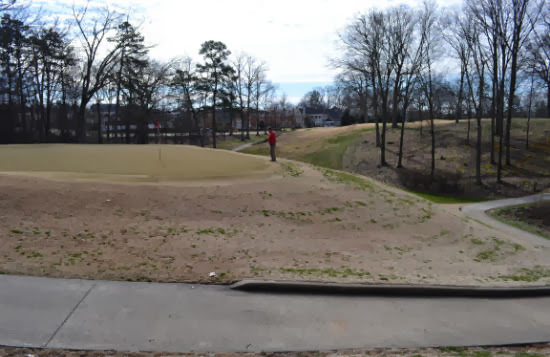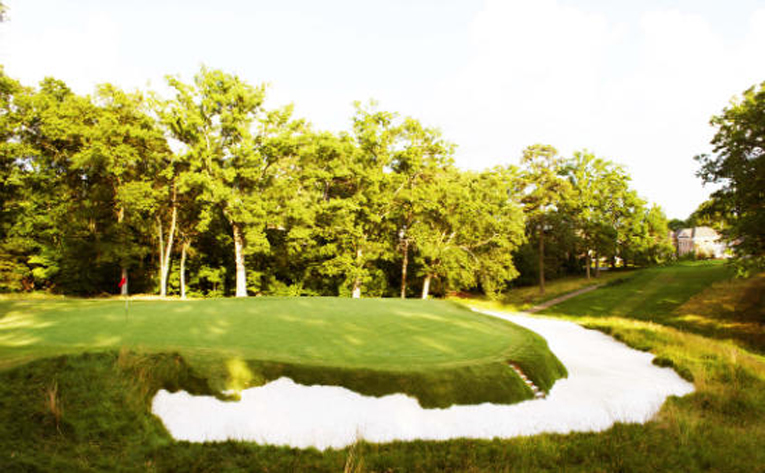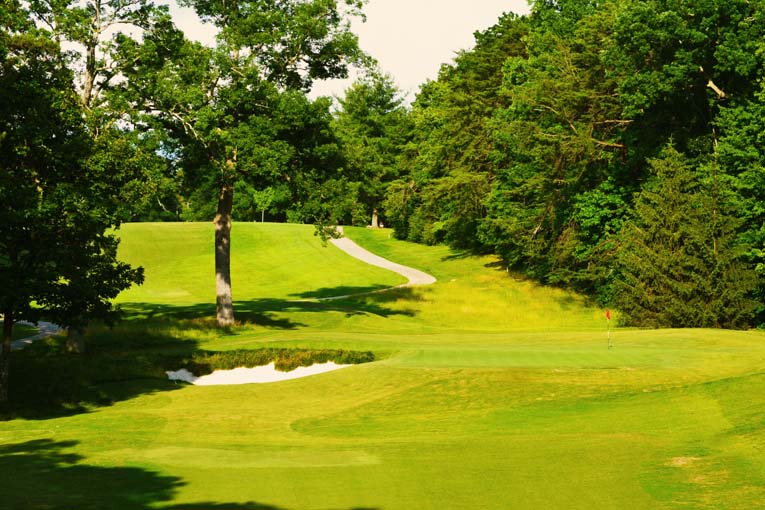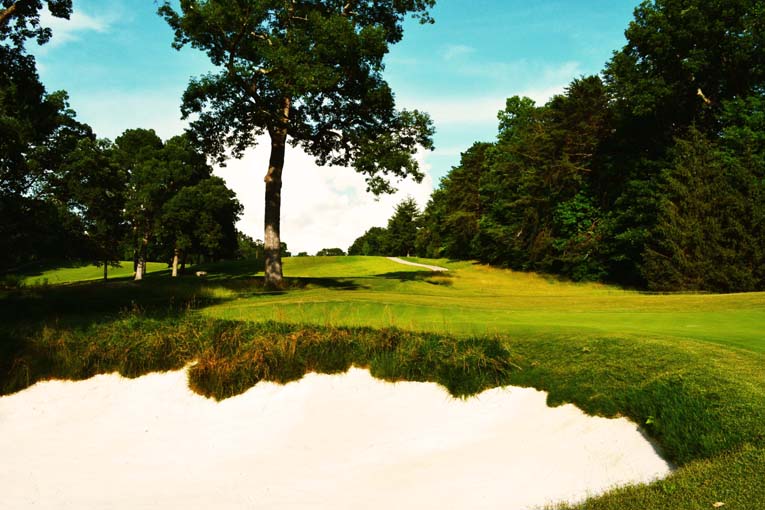Feature Interview with Rob Collins
November, 2014
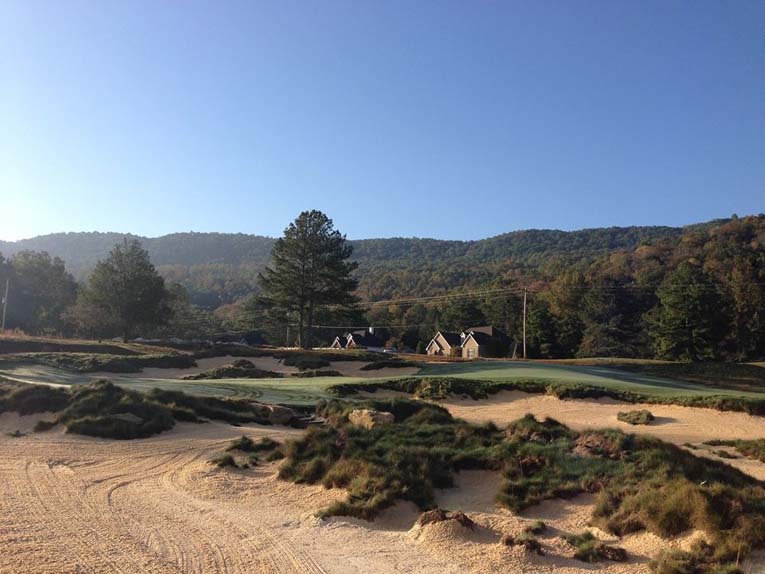
The appealing ninth at Sweetens Cove – a hybrid between a Short and Redan – makes the golfer want to re-loop at this nine hole course.
1. What impact did your trip to Scotland have on you as a 19 year old?
As a rising college sophomore, I was very uncertain about my career path and was beginning to feel a lot of self-imposed pressure about my future even if it didn’t appear that way from the outside. I was fortunate to be asked on an eight day trip in July 1994 by one of my best friends, Zach McClister. We travelled to Scotland with his dad and his dad’s best friend. While there we played the Old and New Course at St. Andrews, visited Muirfield and North Berwick, in addition to viewing the first three rounds of the 1994 Open Championship at Turnberry. At that time, I was only moderately familiar with the game common to the British Isles. It was a thrill to see, firsthand, the type of golf played there. The options, shotmaking opportunities and quirky nature, by comparison to typical American courses, began to open my eyes to a different style of golf than what I was accustomed to seeing at home. I’ll never forget a shot that my friend’s Dad hit that, somewhat ironically, occurred on the New course. I was standing near the green (I don’t remember the hole #) and as I watched his approach shot bound down the fairway toward the green, I thought to myself, “that is one hell of a shot – he’s going to make it to the green”. As soon as I thought that, his ball took a hard left turn and sucked into a virtually inescapable bunker, as if the hazard possessed a very powerful magnet. About four strokes later, he picked the ball up and moved on to the next hole. It was the most fantastic thing I had ever seen on a golf course at that point in my life and I believe that that moment helped me to realize that the unlimited variety and abundance of potential outcomes found on links golf courses are largely absent on the American courses with which I was familiar.
I have no doubt that had I not gone on that trip at that specific time in my life, I wouldn’t be doing what I am doing now. The Old Course itself left me with a desire to learn more about links golf and the qualities that make it the enduring and superior form of the game. As time went by, I developed a fascination with the idea of being able to design and build something that, through its permanence, will provide a source of entertainment and inspiration for future generations, and there is no better example of a course that does that better than The Old Course. I don’t think that there is any doubt that every great course that has ever been built borrows lessons from The Old Course, and conversely, every bad course ever built shuns its teachings.
2. Tell us about your thesis on the environmental impact of golf development at Mississippi State.
One of the primary reasons that I chose Mississippi State for graduate school is due to the fact that the Department of Landscape Architecture was very supportive of my singular desire to pursue a career in golf course design. As such, I tailored my work at Mississippi State, as much as the curriculum would allow, toward the study of golf course architecture. As my course of study matured, I began to develop the belief that the interests of golf development and the environmental movement need not always be diametrically opposed. I consider myself to be an environmentalist, and I often cringe at the mention of “environmentalists” in the context of golf development. As a result, I chose a topic that allowed me to directly test some of my ideas in a real word context, and I finished my thesis, which won a national award for research from the American Society of Landscape Architects, in 2005. The work focused primarily on the Audubon International certification process. Specifically, I compared the quality of wading bird foraging habitat on three Audubon certified and three non-Audubon certified golf courses in SW Florida. Unfortunately, I found that the Audubon certification process does not always guarantee improved environmental quality or deliver on their stated goals. I found this to be very troubling since I believed, and continue to believe, that golf development has the potential to drastically improve upon pre-construction environmental conditions on many sites. Additionally, I feel that any degree of intellectual dishonesty on the part of groups purporting to advocate for an environmentally conscious approach to design and construction do a disservice to the overall industry when reality fails to match the rhetoric.
3. Getting into golf course architecture isn’t easy. What was the interview process like after you graduated?
While my education at Mississippi State was valuable to my career development, I found that my best education came in the field. After sending countless resumes and portfolios, I landed an internship in 2004 with Rick Robbins in Raleigh, NC. Prior to landing that internship, my most interesting interview during that process came with Tom Doak in March of that year. I was a finalist for his internship program and traveled to Traverse City for the interview. I was extremely nervous prior to the interview, as I was well aware of what was at stake: a chance to learn from the guys at the top of the profession about the entire design and construction process. Tom’s interns are given a front row seat on some of the most interesting projects anywhere in the world. I will be the first to admit that I choked — I had a bad interview, which ended up being conducted at Tom’s kitchen table! (His son got sick at school and had to come home early so he moved the interview to his house). After I got the bad news a few weeks later, I wasn’t sure what I would do with my summer. Fortunately, I heard from Rick and it turned out that he had a position available for a three month, summer internship. I was extremely excited for the opportunity and was very grateful to Rick and his team for the opportunity. My wife and I moved to Raleigh with the intention of only being there for three months. As it turned out, the internship went really well and it got extended for an additional six month period. After nine valuable months in Rick’s office, I had experience working on all aspects of the planning process. Additionally, I was able to get out in the field with Rick and one of his associates for some hands on training. Overall, the experience was fantastic and I credit Rick with being the first person to really give me a shot. I’ll forever be grateful for that opportunity and would not be where I am without it. As the internship was winding down, Brian Lussier, one of Rick’s associates, emailed his friend, Frank Henegan, at Gary Player Design to see if they had any availability. Soon after, I found myself working as an on-site design coordinator for the Player Group.
4. What did you learn while working at the Player Group?
My three years with the Player Group turned out to be a hugely important time for me in my professional development. It was with the Player Group that I fell in love with and a gained an understanding of site work. Prior to starting with Player, I had a competing offer from another firm that was an office-based position that would have focused my attention on CAD work and plan production. Had I chosen that route, I have no doubt that it would have been very detrimental to my career. One cannot underestimate the importance of getting as much construction experience as possible. From Frank Henegan and Jeff Lawrence, I learned the fundamentals of designing in the field and how to manage a construction project. As is typical with most construction projects, you have to be able to identify and learn how to deal with the competing interests of the primary stakeholders with an eye toward ensuring that the golf in its final form is of the highest possible quality. Basically, you have to learn how to get what you want and how to deliver on the vision that is in your mind, and I don’t think that that is a skill that can be learned sitting behind a desk hundreds or thousands of miles from a construction project.
5. Where were you when Lehman Brothers collapsed in September, 2008?
My last project with the Player Group was at Wildstone in Cranbrook, BC in the role of on-site design coordinator. During my time on that job, I continued to develop my own thoughts about architecture, while becoming heavily involved in the construction and management of the evolving course. The lead associate on the project, Jeff Lawrence, taught me a great deal about how to envision and then deliver the intended product. The project was seemingly going along very well until it all fell apart in the fall of ’08. I’ll never forget that the day that we grassed the third fairway was the day after Lehman Brothers collapsed. What should have been an exciting day on the project instead felt like a funeral procession.
6. 2009 and 2010 were the nadir for golf course construction in North America. How did you hold in there?
At the time of the Lehman collapse, I had already been told that Player didn’t have any more work for me after that job was finished. Once again, I sent countless portfolios to other firms in a desperate attempt to stay in the business. As the Canadian winter approached, I worked my last day at Wildstone on Halloween day in 2008. My wife and I took the long drive back to Tennessee with our four year old daughter in the backseat and we tried to decide what in the hell we were going to do with our lives. After living at my mom’s house for six months, we finally found our own place. I feel very lucky to have had a place to go with my young family, but those months were the worst time of my life. Everything I had worked for in my professional life was on hold indefinitely and I felt like the proverbial mid 30’s loser who still lives at home. It was a relief to eventually find our own house, and I began to pick up some landscape architecture projects to make some money and stay busy, but my eye never strayed from my primary goal: finding a way back in to golf course architecture. At that point, I had committed eight years of my life to the study of golf architecture. It was my passion and I wasn’t about to give up on it, no matter how bleak the circumstances seemed.
7. What drove Tad King and you to form King-Collins?
Tad and I hit it off immediately after meeting for the first time in 2006. We shared very similar philosophies about the design and construction process and promised to stay in touch after our first project together, knowing that one day we would start King-Collins. As it turned out, the recession was the catalyst that drove us to form King-Collins. Had we both be in steady jobs, it would have been easy to continue to talk about the concept without ever actually acting upon our desire to form the business.
We both felt strongly that the best courses in the world built in the last 25 years had been constructed using the design/build concept, and we each shared a strong love of site work and felt that much of the art and fine details, which are so important to the finished product, were often lost in translation when the typical architect v. contractor model is used for construction. Therefore, we formed our company with the intent of using our own crew to carry out the vision of the design all the while knowing that we would both be heavily involved in the hands on creation of our golf courses. It is our strong belief, and as our work in Tennessee is testament, this method allows us keep costs down while delivering a very high quality product.
8. Tell us about the genesis of the nine holer Sweetens Cove (formerly Sequatchie Valley).
Through a mutual friend, I was introduced to Mark Stovall, the superintendent at Lookout Mountain in 2009. He and I became friends, and through him, I was introduced to Gil Hanse. Gil was hired in ’09/’10 to do a master plan for Lookout Mountain and I was desperate to do anything I could to stay involved in the field. Gil is an architect for whom I have great respect, and I was very excited about the possibility of working for him at Lookout and/or his newest project at Sewanee, my alma mater. It looked like I might get that opportunity when, through Mark, I was introduced to King Oehmig, the man who is more responsible than anyone for making the renovation at Sewanee a reality. I reached out to King in the spring of 2010 to see about the possibility of helping out at Sewanee. He was genuinely happy to meet me and offered that he would do what he could to get me involved at Sewanee. In the meantime, he mentioned that he had heard that the Thomas Family (owners of Sequatchie Concrete) had a nine-hole golf course that they were considering renovating. King offered to provide the introduction to Bob Thomas, the founder of Sequatchie Concrete, and King and I planned to go check out the course one sunny, spring afternoon. We met at the Krystal in Kimball, TN and drove out to see the property.
Tad and I later toured the site together for the first time in July 2010, and we immediately proposed a total overhaul of the existing layout. The course at that time was far and away the worst golf course either of us had ever seen. Corridors were cramped by trees. The site was entirely flat, with only one foot of fall over 600+ yard width of the of the property, and maintenance standards were virtually non-existent. I actually had a moment on the property one day where I wondered aloud “what in the hell am I doing with my life”? The course, however, had two redeeming qualities: it was located on a beautiful site and the bones of the routing were quite good. After months of proposals, we were finally commissioned to carry out our plan in March 2011. After months of dreaming about what I would do with the site if given the opportunity, the project was finally going to go ahead! I decided that I wanted the course to be completely different from all of the other courses in the area, and I set a goal to design and help build the best nine holes in the state. At the end of the project, I wanted our client to be able to say that no other course in Tennessee had a front or back nine as good as the nine on their layout. While it was important to me that the course stand out aesthetically from the pack, I also wanted the course to have playing characteristics that were similar to some of my favorite layouts. My hope was that people would have similar shots and playing scenarios as what they might encounter at Pinehurst, Pine Valley, Saint Andrews, Tobacco Road or Lookout Mountain, but, at the same time, I wanted the overall experience to be unique in a way that it would be difficult for people to pinpoint exactly where they had “seen that before”. In other words, I wanted the boldness and audacity of the features on the course to disguise much of their ancestral heritage. The course was to be rooted in the fundamentals of sound, strategic design but I intended for those elements to be expressed in a unique and refreshing way.
9. Walk us through its construction. Who did the shaping?
As part of our contract, I committed myself fully to the project, and in addition to my daily presence on site, we were allowed to bring in a shaper. Gus Grantham, the lead shaper on the project, had his first day on site June 2, 2011. Gus did a simply brilliant job of handling the earthworks, bulk grading, and detail shaping. With nine holes opened up in the summer on 2011, Gus and I had our hands full trying to manage and coordinate the daily construction process.
It was decided that Sequatchie Concrete’s local construction crew would assist with labor, drainage installation, etc. in order to help reduce costs. While their work was invaluable to the project, their lack of previous golf experience meant that 99% of the most important work was completed by three people: Gus, Tad, and me. As it turned out, we were very fortunate that Tad’s schedule opened up in 2011-12, and he was able to relocate to Tennessee from a stalled project in Egypt where he had been working. Tad expertly managed the remaining months of the construction project while he simultaneously sand capped (with over 2,000 loads of sand) and finish detailed the fairways, greens, and tees as I spent the majority of my time on the latter half of the project cultivating the bunker detail work.
In addition to the aforementioned main players, we were excited to have an assist from Dan Proctor. I developed a relationship over the years with Dave Axland and I reached out to him to see if any of the Coore & Crenshaw guys were looking for extra work. Fortunately, Dan was free and he came out for several months in the summer of 2011. His work focused primarily on the early detail work on the bunkers on the 7th, 8th, and 9th holes. It was great having Dan around. He is truly one of my favorite people, in or out of the golf world.
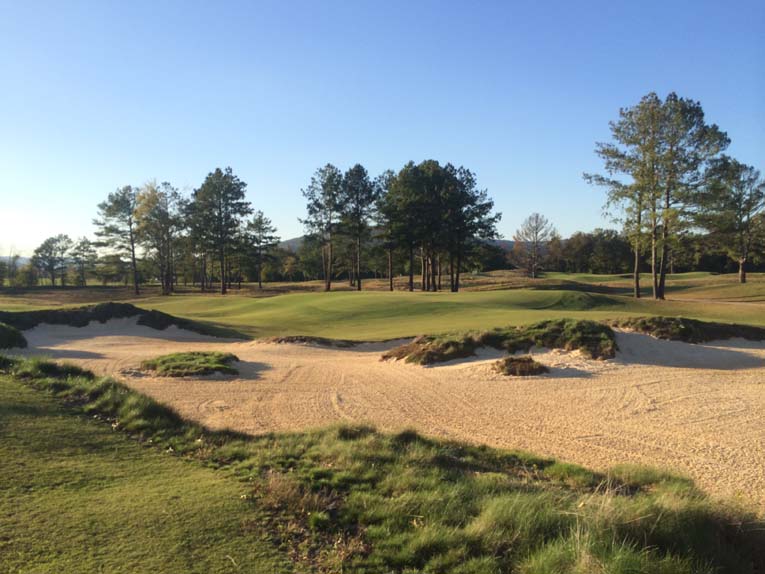
The domed green surrounded by short grass joins ‘Dan’s bunker’ in the foreground in providing the challenge at the 315 yard seventh.
Last, but certainly not least, the client hired Michael Burrows as the superintendent. Michael’s previous experience includes stops at Merion, Austin Golf Club, and Streamsong. He was the ideal choice for the job and his passion for the layout has also made a huge impact on the project.
10. You mentioned it was sand-capped. Where in the world did the sand come from in the mountains of Tennessee?!
Our client owns a large sand plant on Monteagle Mountain, which is about 25 minutes from the golf course. Incidentally, the sand that was used to cap Gil Hanse’s renovated Sewanee Golf Course came from the same source.
11. What impact did the sand offer you, both from a design/shaping perspective and from an agronomic one?
The sand resource made the finish work infinitely easier since the native soil is heavy clay. Additionally, drainage and overall turf quality are elevated as a result of having sand capped the golf course. Amazingly, Tad handled over 2,000 dump trucks in the spring and early summer of 2012 as we finished and grassed the layout.
12. Tell us how Sweetens Cove embodies your philosophy on slopes/contours.
To complement the broad scale of the property, we opened up views across the land through selective clearing and built large and expansive features. As the course took shape and evolved, it was clear that my goal of bringing contour into the strategic fabric of the layout would be achieved. Big, broad rolls and massive slopes were being created in and around the green complexes that would force the golfer to choose the optimal angle of attack into each green complex. Rather than setting up strategy with only bunkers and/or water, much of the lasting interest of the layout will be derived from the macro and micro contours of our green complexes — they simply cannot be ignored and must be reckoned with throughout one’s round. It is my opinion that the degree of influence of contour is directly related to the permanence of any design. Without having to consider slope, etc. a course will quickly lose its appeal. Conversely, the courses that successfully force the golfer to deal with vagaries of contour create a lasting appeal, as holes will tend to play differently from one day to the next. In addition to focusing on creating artistic features throughout the layout, these maxims were ringing in my ears throughout the construction process.
13. Describe a favorite hole and what you like so much about it.
While it is nearly impossible to select one hole as my favorite above the rest, I’ve always had a special place in my heart for the fifth. Prior to construction, I realized that the ground upon which the fifth hole sits had the potential to yield a fantastic, short par four. I’ve had an affinity for drivable, gambling par fours for as long as I can remember, and I was intent on creating a unique hole with those qualities. The fifth is only 283 yards on a direct line from the tips to the center of the green, but the extremely wide variety of possible scores and potential outcomes ensures that it will rarely play the same from one round to the next. The hole itself is very expansive with a fairway that stretches to 100 yards at its widest point. When combined with the severely contoured, boomerang green which wraps around an extremely penal, sleeper-lined pot bunker, the player has a lot to consider when planning how best to attack each pin on the massive green, knowing that the strategy of the hole changes with each pin.
14. What is the present state of Sweetens Cove?
I am thrilled to be able to say that the course officially opened Thursday, October 23rd!! To say that it has been a long road would be a massive understatement! I was approached by the Thomas family in late 2013 after the project had been shut down to gauge my interest in potentially operating and launching the golf course. After searching for months for potential partners, I was called ‘out of the blue’ by Mark Stovall (the project comes full circle here) in November 2013 to see if it would be ok if Ari Techner and Patrick Boyd toured the golf course. Of course I was delighted to show them around. I vividly remember meeting them for the first time on a cold, dreary Fall day. They both enthusiastically embraced the spirit of the course and the architecture, which was certainly a boon to my psyche, which was not in the best state after I watched my baby get finished and then abandoned within the same month. A few days after their visit, Ari emailed me to see if I would be interested in partnering with him in an effort to take over the golf course on a long term lease. I enthusiastically replied that I was on board, and we set off in tandem to save Sequatchie Valley/Battle Creek/Sweetens Cove. After six months of occasionally laborious negotiations, Ari and I were in full control of the golf course and we set about reviving the architecture that existed underneath a thick layer of weeds and dead grass. I personally spent the last five months, along with our superintendent, Michael Burrows, resurrecting the course from the dead, and we are very happy to say that it is ready for play! The long term plans for the course will include a Scratch Golf fitting center and club making studio, which will allow customers to test clubs on the course, practice area, and driving range.
15. Golf course architecture can be a viciously cruel profession. Near the top of the list surely must fall having a great piece of property within your grasp, only to see it slip away and never be used for golf. Tell us about the prospects for a course you uncovered in British Columbia.
When we were living in Cranbrook, BC, we became friends with a couple who had two girls around the age of our daughter. Through them, I came to know the developer of a property in Fernie, BC, which was home to some of the most natural and dramatic golfing terrain that I have ever seen. In 2007/08, my client was a minority partner in a group that hired David McLay Kidd to build a course on the property. I was invited to tour the property in September 2008, ironically in the days following the Lehman Brothers collapse, with my client and our mutual friend. I was immediately blown away by the property and I remember telling myself that I would “one day have an opportunity on a site like that”. I knew that DMK had essentially come out of nowhere to have a successful career and I hoped to one day be in a similar position as him. I never would have dreamed that my first big opportunity might come on the same piece of ground five years later!! The event that laid the foundation for my eventual return to Fernie was a family vacation to Cranbrook/Fernie last summer (2013). While there, we had plans to meet our friends at dinner with some of their friends. As it turned out, my client was there (he and I were friendly acquaintances at the time). I asked him about the project and he told me that he was now fully in control of the land (the previous ownership group went bankrupt and he bought the land off of receivership). He said that he hadn’t spoken to any other architects and that he wanted us to create a plan and a construction budget for the proposed layout. I immersed myself into the opportunity and committed to designing what I felt would be the most unique mountain golf course anywhere in the world. While most mountain golf courses suffer the indignity of forced/cramped holes, huge earthworks that never seem to tie in, etc., the property in Fernie was easy to walk, possessed outrageous views of the surrounding Rocky Mountains, and contained a unique variety of holes. There are holes that stretch across a flattish section of property that are adorned with magnificent natural drainage swales and burnt cedars, there are holes that stretch along Coal Creek, another section in an exposed meadow, and the finishing flourish comes in the boldest section of the property at the base of a mountain. At 6,500 yards, I envisioned the course to be primarily a walking course with 90+ acres of tightly mown turf. While most mountain courses in that part of the world have bent or Kentucky blue fairways, which never seem to play fast, we planned to plant all of our fairways with a fine fescue blend, thereby ensuring that the ground game would be a central part of the experience. I felt like these links-like characteristics were entirely achievable and would have set the course apart from the competition. In the same way that I set out to differentiate the nine holes in TN from the competition, I wanted to do something in Canada that would be refreshing take on the mountain golf theme. Unfortunately, I recently found out that the land upon which the golf course would have been built will instead include trails, open space, houses, and condos.
Obviously, this was a huge disappointment, as I spent over a year looking for money for our construction budget, which, incidentally, was 1/5 the amount that a well-known “Signature” designer quoted to my client in 2006 prior to DMK’s involvement with the project. I have no doubt that we would have built one of the world’s best courses if we had been given the opportunity. In line with our methodology, the construction work would have been carried out by me, Tad, Gus, and our good friends at Integrative Golf, Trevor Dormer, Riley Johns, and Dan Philcox. I met the guys from Integrative during my time in Cranbrook on the Wildstone project. We all hit it off famously and have stayed in touch through the years. Naturally, I reached out to them when I was hired by our client to create a plan and construction budget. In October 2013, Tad, Riley, Trevor, and I routed the course and solidified the vision of what would become the Montane Club.
To think about it today makes me sick to my stomach. The entire course was great, but the finishing flourish was as good as anything I have ever seen. The back nine, which would have contained three (3) par fives and four (4) entirely unique and fresh par threes would have rivaled any back nine for fun, drama, and scenery. Starting with the fourteenth hole, which would’ve played as a short par 3 across Coal Creek to a naturally heaving, reverse redan green, the drama would have organically grown from there. The next hole (15), was a reachable par 5, which would have played steeply uphill to an Alps green hidden behind a natural ridge that would have been adorned with outrageously penal and artistic bunkering. The sixteenth, a redan par three, was home to a natural and outrageous green site, which would have been situated about 60 yards to the north of the Alps. The seventeenth hole was the Rocky Mountain equivalent of the seventh hole at Pebble Beach. Sheer cliffs surrounded the green on three sides with panoramic views of the Rocky Mountains and Coal Creek from the tee. The home hole was a gambling 460 yard par four from the back tees that played across Brewer’s Creek and a series of natural drainage swales, which we planned to adorn with highly artistic bunkering, toward a heaving green that was an extension of our ‘Rocky Mountain putting green’, an ode to the famous ‘Himalayas.’ Each of these holes would have unfolded under the shadows of the Lizard Range in the magnificent Canadian Rockies and would’ve contained natural, massive free-form teeing grounds a few yards from each green. Yeah, I am just a wee bit disappointed that it didn’t come off….
16. Please layout and describe your favorite par 3, par 4 and par 5 as you had designed them on paper.
My description of the par three sixteenth, which would’ve been named “Ghost Tree” after the valley of burnt cedars between the tee and the green:
How to maintain the frenetic pace set by the last few holes? Surely an indifferent hole is in store for players. If not indifferent, something mundane, or just ordinary is around the corner? Ghost Tree, which plays across a graveyard of burnt cedars, is clearly not an affirmative answer to these understandable questions. This entirely unique redan, one shotter shares a bailout area with the previous hole and utilizes the perfect redan-like, existing right to left contours to its best advantage, encouraging players to play to the far right side of the green in order to access the difficult left-hand pins while avoiding the hazards on either side of the putting surface. This timeless, strategic hole borrows from some of the greatest redan holes ever built, but still manages to put its own unique spin on the template with the com¬bination of distinctive natural contours, outrageous scenery, and the valley of burnt cedars, from which the hole borrows its name.”
My description of the par four second, which would’ve been named ‘Barn’ after the iconic red barn on the low part of the property:
A seamless transition from the back of the first green to the expansive teeing ground of the second hole, nicknamed Barn, will set the tone for the remainder of the round, as quick, uncluttered movement from one hole to the next will be central to the overall experience. The outrageously wide playing corridor of the second will tie into the nearby seventh hole and the teeing ground of the third. Expansive width will be another recurring theme of the course, as strategic options and alternate routes of attack to every green will be the norm. For this hole, bold golfers will have the option to drive the green but they must negotiate the elaborately detailed and highly distinctive fairway and greenside bunkers, which will be shaped into the existing, natural drainage swales. The safe tee shot is to the broad swath of turf short and right of the fairway bunkering. Approaches from this angle will have to contend with the shallow green and its surrounding hazards. The strategic dilemmas, width, and angle of the green will be reminiscent of the famous tenth hole at Riviera, which is regarded by many as being the finest short par four on the planet.
My description for the par five fifteenth, which would’ve been named ‘Proctor’ after Mt. Proctor, which looms over Fernie, and Dan Proctor:
“After coming off the short, highly entertaining Cirque, players are confronted with a steep uphill tee shot on the par five fifteenth, Proctor. With the Lizard Range peeking over the horizon, players are once again reminded that they have encountered a highly distinctive layout. Refusing to serve as a letdown after the previous stretch of holes, Proctor stands out as one of the most unique ‘Alps’ holes in the world. Modeled after the famous seventeenth hole at Prestwick, Proctor’s natural punchbowl green is tucked behind the existing rise at the apex of the fairway. Players who succeed in carrying the centrally placed, extremely penal, sod-wall bunker, which will be carved into the top of the rise, will see their ball disappear over the horizon. As they walk to the top, a profound sense of anticipation will be their companion. Did their ball catch the gathering contours and bound onto the massive, 12,500 square foot punchbowl green? With a little bit of luck and a touch of skill, many will find that they are mercifully putting for eagle, potentially setting up an epic finish.”
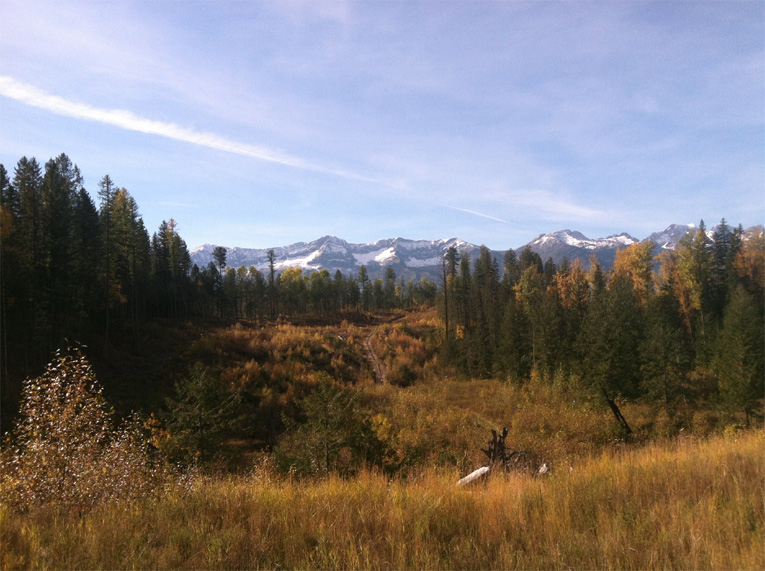
As seen from the tee, the fifteenth was going to be an Alps with a massive green on the far side of the distant ridge.
17. WOW! What a great, great shame but good on you for coming up with such sterling holes even if they were never built. Back home in Tennessee, tell us about your work at Signal Mountain Golf & Country Club.
In addition to the project in Fernie, we were hired to do some bunker & green work on two holes at Signal Mountain G&CC in February of 2013. Signal Mountain is the course that I grew up playing and I have a very special place in my heart for the layout. Unfortunately, it underwent a terrible renovation in the late 90’s. Along with having far too many trees on the layout, the green complexes fail to relate to the compelling, natural contours on the site. The course has loads of potential, and I have presented a master plan proposal to the board, and we are fortunate to have the support of their excellent superintendent, Pat Rose, formerly of Oakmont and Fox Chapel, and several prominent members.
Regarding our renovation work, we proposed rebuilding the bunkers on two of the course’s par threes, the third and the seventeenth. While reducing overall maintenance costs was our primary concern, we also wanted to improve the aesthetics, playability, and strategy on both holes. Prior to the renovation, both holes had unnecessary bunkers that were overly penal to the weak golfer and simultaneously failed to provide any strategic interest. On the third, a 135 yard par three, we removed the bunker on the right side of the green and created a small bench or plateau that will help collect wayward shots and will be maintained at fairway height, thereby maximizing potential shotmaking variety in recovery efforts. The left greenside bunker was extended slightly to the right and was wrapped around the left and rear of the green. This change helped establish the strong, natural diagonal of the green and created a fascinating back left, peninsula pin placement. Additionally, balls that miss the left side of the green are no longer lost forever in gully in front of the tees at the fourth. Interestingly, this ‘savior’ characteristic of the new bunker will embolden many to attempt to attack pins on the left side, making the hole dramatically more interesting and fun to play. Golfers now have a tantalizing shot where they can bite off as much as they choose. I find that this risk-reward scenario is especially interesting on a short hole, as most one shotters of similar distance do not have these playing characteristics.
At seventeen, a 170 yard par three, we removed two bunkers and extended the green, adding approximately 900 square feet of new space to the back left side of the putting surface. On the right side of the green, a small, useless pot bunker was replaced with a swale that will be maintained at fairway height, from which golfers will have the option of utilizing a wide variety of clubs for their recovery. On the short left side of the green, we deleted another bunker that was far removed from the green surface and was seemingly built only to annoy high handicappers and the maintenance staff, alike. In the general vicinity of the previous left greenside bunkers, we built a strong, strategic bunker that sits in the elbow of the refurbished green, which is now shaped like the number ‘7’. The back left pin is truly wicked, but golfers now have ample bailout area if they choose to avoid the line of charm.
18. What’s an example of making a hole hard for a good player and yet still manageable and fun for the rest of us that lack talent?
I think I have to revert to the fifth hole at Sweetens Cove to answer this question. In the time since it was built, I’ve seen plus handicaps and players who would barely register on the USGA handicap system attempt to unwind its subtleties. Personally, I’ve scored anything between a two and the dreaded “other”. I’ve also had the pleasure of watching a number of great players who found themselves trapped inside the greenside bunker, which is lined with railway sleepers, struggling to make a double bogey. My favorite memory of this hole, however, comes from earlier this summer when I saw what I can only term as a “terrible golfer” attempt a shot to the pin, which was viciously tucked behind the greenside bunker, from 80 yards out. Naturally, he pulled out some sort of fairway wood, which he inevitably topped, that resulted in a ball that bounded recklessly toward the green and the gaping, greenside hazard. Miraculously, his ball skirted just to the right of the greenside bunker and took a hard left turn with the strong contours on a direct line toward the pin, with the ball eventually resting dead at the hole. Whether or not he made the putt is irrelevant in my mind. That incident proved to me that the hole had the potential to play as I intended, which is a hugely satisfying feeling. Clearly, the pin behind the bunker is the most severe on the green, but it was important to me in the construction process that we ensure that weaker golfers could access this ‘Sunday location’ through other means than an aerial ball flight. Accordingly, the contours were meticulously fashioned to allow players to attempt a running shot, a characteristic that is common to every hole at Sweetens Cove.
19. When you think great golf, eastern Tennessee isn’t the region that springs to mind first. And yet, few non-metropolitan areas in the country offer golf of the quality found at Holston Hills, Lookout Mountain, The Honors Course, Black Creek and your work. Tell us more about your area. Is there a restoration begging to be done? Any chance of new construction?
Chattanooga definitely has some very strong golf courses for a relatively small market. There is a Ross course owned by the City of Chattanooga, which was renovated in the 60’s or 70’s, known as Brainerd Golf Course that, if restored, could be a very fine layout. Several of Ross’ original drawings are actually in the Tufts archives and it is clear that much of what once made the course special has been lost over time. I think it would be a tremendous asset to Chattanooga to have a restored Ross municipal golf course.
As many people in this forum know, Gil Hanse has been hired to put the finishing touches on Lookout Mountain. Once complete, I think Lookout will rank as one of the best courses in the country. As is, it is an incredibly fun, engaging, and quirky layout and, once renovated, it will be incredible.
I also feel very strongly that Signal Mountain has a tremendous amount of potential. The natural terrain is excellent and the routing is sound. It would be one of my dream jobs to get the opportunity to maximize the potential of the course where I first played the game. With wide corridors, a clearing plan, more native areas, strategic scenarios throughout the course, and shotmaking options that take advantage of the natural contours, the golf course would be very special. I hope one day to embark on a plan that would bring the aforementioned characteristics to the Club.
As far as new construction is concerned, there is a multitude of great land around Chattanooga where you could build world class golf. And, Chattanooga is a very popular place right now. It’s growing and is considered one of the best small towns in America. I wouldn’t be surprised if I got to do a new course in the area one day – hopefully, sooner than later!!
The End





